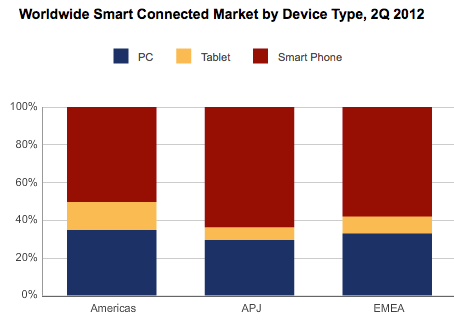Evidence of market saturation in the U.S. can be seen in new research from IDC that takes a look at the global connected device market. Shipments and revenues declined here, even as worldwide market share grew. The connected device market, meaning smartphones, tablets, and PCs combined, grew 27.4% year-over-year in Q2 2012, IDC says. There was also a slight bump of 2.8% growth from Q1 to Q2. However, although total revenue was at $131.5 billion worldwide – 16.3% higher than the previous year – there was a 2.7% decline in revenue quarter-over-quarter.
In the U.S., the drops were significant, in terms of both shipments and revenue. Unit shipments for Q2 2012 fell 7.8% from last quarter, and were down 5% from the past year to just under 47.4 million units. Revenues dropped to $24.8 billion, a 10.3% decline from the previous quarter, and a 8.6% drop year-over-year. IDC says these numbers are a result of both the economy and, to some extent, the impact of market saturation.
The U.S. aside, IDC is still forecasting continued growth in the space, with worldwide total unit shipments for connected devices reaching nearly 1.2 billion in 2012, a 27.4% increase over 2011. The analysts believe that by 2013, that number will grow to 1.4 billion, a 19.2% year-over-year increase. By 2016, there will be 2 billion connected devices, with the Asia/Pacific region leading with over 860 million units. The Americas are forecast to have 600 million by 2016 and the EMEA region, 530 million.
Smartphones in particular, now accounting for 59% of connected device shipments, will grow 15.8% annually, to reach nearly 63% of shipments by 2016. Tablets will grow the fastest, though, rising from a 10% share in 2012 to 13% by 2016, eating into PC share, which will drop from 31% to 24% during the same time. In the EMEA region, IDC says tablets will gain share, while in the Americas and Asia/Pacific regions, volume will increase, but share will be smaller than the global total during this forecast period.
